[English] 日本語
 Yorodumi
Yorodumi- PDB-7acz: RdeltaD2 H/L (LMW SLP/HMW SLP) complex from C. difficile SlpA (R2... -
+ Open data
Open data
- Basic information
Basic information
| Entry | Database: PDB / ID: 7acz | ||||||
|---|---|---|---|---|---|---|---|
| Title | RdeltaD2 H/L (LMW SLP/HMW SLP) complex from C. difficile SlpA (R20291 strain) | ||||||
 Components Components |
| ||||||
 Keywords Keywords |  STRUCTURAL PROTEIN / Bacterial surface / STRUCTURAL PROTEIN / Bacterial surface /  S-layer S-layer | ||||||
| Function / homology |  : :  Function and homology information Function and homology information | ||||||
| Biological species |   Clostridioides difficile (bacteria) Clostridioides difficile (bacteria)  Clostridioides difficile R20291 (bacteria) Clostridioides difficile R20291 (bacteria) | ||||||
| Method |  X-RAY DIFFRACTION / X-RAY DIFFRACTION /  SYNCHROTRON / SYNCHROTRON /  MOLECULAR REPLACEMENT / Resolution: 3.5 Å MOLECULAR REPLACEMENT / Resolution: 3.5 Å | ||||||
 Authors Authors | Lanzoni-Mangutchi, P. / Barwinska-Sendra, A. / Salgado, P.S. | ||||||
| Funding support |  United Kingdom, 1items United Kingdom, 1items
| ||||||
 Citation Citation |  Journal: Nat Commun / Year: 2022 Journal: Nat Commun / Year: 2022Title: Structure and assembly of the S-layer in C. difficile. Authors: Paola Lanzoni-Mangutchi / Oishik Banerji / Jason Wilson / Anna Barwinska-Sendra / Joseph A Kirk / Filipa Vaz / Shauna O'Beirne / Arnaud Baslé / Kamel El Omari / Armin Wagner / Neil F ...Authors: Paola Lanzoni-Mangutchi / Oishik Banerji / Jason Wilson / Anna Barwinska-Sendra / Joseph A Kirk / Filipa Vaz / Shauna O'Beirne / Arnaud Baslé / Kamel El Omari / Armin Wagner / Neil F Fairweather / Gillian R Douce / Per A Bullough / Robert P Fagan / Paula S Salgado /   Abstract: Many bacteria and archaea possess a two-dimensional protein array, or S-layer, that covers the cell surface and plays crucial roles in cell physiology. Here, we report the crystal structure of SlpA, ...Many bacteria and archaea possess a two-dimensional protein array, or S-layer, that covers the cell surface and plays crucial roles in cell physiology. Here, we report the crystal structure of SlpA, the main S-layer protein of the bacterial pathogen Clostridioides difficile, and use electron microscopy to study S-layer organisation and assembly. The SlpA crystal lattice mimics S-layer assembly in the cell, through tiling of triangular prisms above the cell wall, interlocked by distinct ridges facing the environment. Strikingly, the array is very compact, with pores of only ~10 Å in diameter, compared to other S-layers (30-100 Å). The surface-exposed flexible ridges are partially dispensable for overall structure and assembly, although a mutant lacking this region becomes susceptible to lysozyme, an important molecule in host defence. Thus, our work gives insights into S-layer organisation and provides a basis for development of C. difficile-specific therapeutics. | ||||||
| History |
|
- Structure visualization
Structure visualization
| Structure viewer | Molecule:  Molmil Molmil Jmol/JSmol Jmol/JSmol |
|---|
- Downloads & links
Downloads & links
- Download
Download
| PDBx/mmCIF format |  7acz.cif.gz 7acz.cif.gz | 471 KB | Display |  PDBx/mmCIF format PDBx/mmCIF format |
|---|---|---|---|---|
| PDB format |  pdb7acz.ent.gz pdb7acz.ent.gz | 330.4 KB | Display |  PDB format PDB format |
| PDBx/mmJSON format |  7acz.json.gz 7acz.json.gz | Tree view |  PDBx/mmJSON format PDBx/mmJSON format | |
| Others |  Other downloads Other downloads |
-Validation report
| Arichive directory |  https://data.pdbj.org/pub/pdb/validation_reports/ac/7acz https://data.pdbj.org/pub/pdb/validation_reports/ac/7acz ftp://data.pdbj.org/pub/pdb/validation_reports/ac/7acz ftp://data.pdbj.org/pub/pdb/validation_reports/ac/7acz | HTTPS FTP |
|---|
-Related structure data
- Links
Links
- Assembly
Assembly
| Deposited unit | 
| |||||||||||||||||||||||||||||||||||||||||||||||||||||||||||||||||||||||||||||||||||||||||||||||
|---|---|---|---|---|---|---|---|---|---|---|---|---|---|---|---|---|---|---|---|---|---|---|---|---|---|---|---|---|---|---|---|---|---|---|---|---|---|---|---|---|---|---|---|---|---|---|---|---|---|---|---|---|---|---|---|---|---|---|---|---|---|---|---|---|---|---|---|---|---|---|---|---|---|---|---|---|---|---|---|---|---|---|---|---|---|---|---|---|---|---|---|---|---|---|---|---|
| 1 | 
| |||||||||||||||||||||||||||||||||||||||||||||||||||||||||||||||||||||||||||||||||||||||||||||||
| 2 | 
| |||||||||||||||||||||||||||||||||||||||||||||||||||||||||||||||||||||||||||||||||||||||||||||||
| Unit cell |
| |||||||||||||||||||||||||||||||||||||||||||||||||||||||||||||||||||||||||||||||||||||||||||||||
| Noncrystallographic symmetry (NCS) | NCS domain:
NCS domain segments:
NCS ensembles :
|
- Components
Components
| #1: Protein | Mass: 19262.543 Da / Num. of mol.: 2 Fragment: SLPL deltaD2 (LMW SLP D2 truncation) from C. difficile (R20291),SLPL deltaD2 (LMW SLP D2 truncation) Mutation: deleted aa 115-259 Source method: isolated from a genetically manipulated source Source: (gene. exp.)   Clostridioides difficile (strain R20291) (bacteria) Clostridioides difficile (strain R20291) (bacteria)Strain: R20291 / Gene: slpA, CDR20291_2682 / Plasmid details: RT027, SLCT4 / Production host:   Clostridioides difficile R20291 (bacteria) / References: UniProt: C9YQ17 Clostridioides difficile R20291 (bacteria) / References: UniProt: C9YQ17#2: Protein | Mass: 44085.027 Da / Num. of mol.: 2 / Fragment: SLPH (HMW SLP) from C. difficile (R20291) / Source method: isolated from a natural source Source: (natural)   Clostridioides difficile R20291 (bacteria) Clostridioides difficile R20291 (bacteria)Plasmid details: RT027, SLCT4 / References: UniProt: C9YQ17 Has ligand of interest | N | |
|---|
-Experimental details
-Experiment
| Experiment | Method:  X-RAY DIFFRACTION / Number of used crystals: 1 X-RAY DIFFRACTION / Number of used crystals: 1 |
|---|
- Sample preparation
Sample preparation
| Crystal | Density Matthews: 2.72 Å3/Da / Density % sol: 54.87 % |
|---|---|
Crystal grow | Temperature: 293.15 K / Method: vapor diffusion, sitting drop / pH: 6 Details: 0.1 M MES pH 6.0 0.875 M Lithium chloride 11.5% PEG 6,000 10% Glycerol |
-Data collection
| Diffraction | Mean temperature: 100 K / Serial crystal experiment: N |
|---|---|
| Diffraction source | Source:  SYNCHROTRON / Site: SYNCHROTRON / Site:  Diamond Diamond  / Beamline: I24 / Wavelength: 0.9686 Å / Beamline: I24 / Wavelength: 0.9686 Å |
| Detector | Type: DECTRIS PILATUS3 6M / Detector: PIXEL / Date: Sep 28, 2018 |
| Radiation | Protocol: SINGLE WAVELENGTH / Monochromatic (M) / Laue (L): M / Scattering type: x-ray |
| Radiation wavelength | Wavelength : 0.9686 Å / Relative weight: 1 : 0.9686 Å / Relative weight: 1 |
| Reflection | Resolution: 3.5→52.74 Å / Num. obs: 16691 / % possible obs: 98.75 % / Redundancy: 3.4 % / Biso Wilson estimate: 37.95 Å2 Details: The Rmerge is very high for this crystal due to merging of data from 2 highly anisotropic crystals, that are also not completely isomorphous. However, this was necessary to generate ...Details: The Rmerge is very high for this crystal due to merging of data from 2 highly anisotropic crystals, that are also not completely isomorphous. However, this was necessary to generate interpretable electron density maps, as data from either crystal separately was enough. CC1/2: 0.616 / CC star: 0.873 / Rmerge(I) obs: 0.5102 / Rpim(I) all: 0.3238 / Rrim(I) all: 0.6068 / Net I/σ(I): 10 |
| Reflection shell | Resolution: 3.5→3.63 Å / Redundancy: 3.5 % / Rmerge(I) obs: 0.9043 / Mean I/σ(I) obs: 2.47 / Num. unique obs: 1620 / CC1/2: 0.438 / CC star: 0.78 / Rpim(I) all: 0.5631 / Rrim(I) all: 1.069 / % possible all: 97.03 |
- Processing
Processing
| Software |
| ||||||||||||||||||||||||||||||||||||||||||||||||||||||||||||||||||||||||||||||||||||
|---|---|---|---|---|---|---|---|---|---|---|---|---|---|---|---|---|---|---|---|---|---|---|---|---|---|---|---|---|---|---|---|---|---|---|---|---|---|---|---|---|---|---|---|---|---|---|---|---|---|---|---|---|---|---|---|---|---|---|---|---|---|---|---|---|---|---|---|---|---|---|---|---|---|---|---|---|---|---|---|---|---|---|---|---|---|
| Refinement | Method to determine structure : :  MOLECULAR REPLACEMENT MOLECULAR REPLACEMENTStarting model: Dep D_19292110995 Resolution: 3.5→52.74 Å / SU ML: 0.4221 / Cross valid method: FREE R-VALUE / σ(F): 1.96 / Phase error: 31.17 Stereochemistry target values: GeoStd + Monomer Library + CDL v1.2
| ||||||||||||||||||||||||||||||||||||||||||||||||||||||||||||||||||||||||||||||||||||
| Solvent computation | Shrinkage radii: 0.9 Å / VDW probe radii: 1.11 Å / Solvent model: FLAT BULK SOLVENT MODEL | ||||||||||||||||||||||||||||||||||||||||||||||||||||||||||||||||||||||||||||||||||||
| Displacement parameters | Biso mean: 37 Å2 | ||||||||||||||||||||||||||||||||||||||||||||||||||||||||||||||||||||||||||||||||||||
| Refinement step | Cycle: LAST / Resolution: 3.5→52.74 Å
| ||||||||||||||||||||||||||||||||||||||||||||||||||||||||||||||||||||||||||||||||||||
| Refine LS restraints |
| ||||||||||||||||||||||||||||||||||||||||||||||||||||||||||||||||||||||||||||||||||||
| Refine LS restraints NCS |
| ||||||||||||||||||||||||||||||||||||||||||||||||||||||||||||||||||||||||||||||||||||
| LS refinement shell |
| ||||||||||||||||||||||||||||||||||||||||||||||||||||||||||||||||||||||||||||||||||||
| Refinement TLS params. | Method: refined / Origin x: 6.83834376163 Å / Origin y: -36.3952231107 Å / Origin z: 10.2700128284 Å
| ||||||||||||||||||||||||||||||||||||||||||||||||||||||||||||||||||||||||||||||||||||
| Refinement TLS group | Selection details: all |
 Movie
Movie Controller
Controller



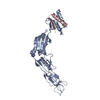
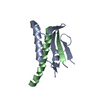
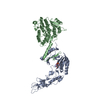
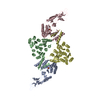



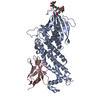

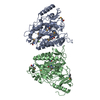




 PDBj
PDBj